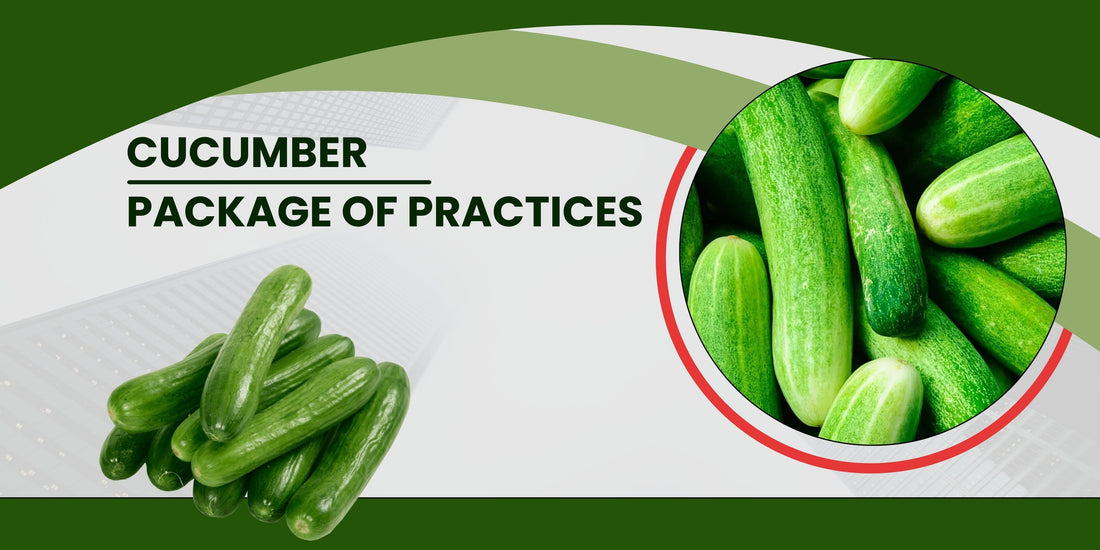
CUCUMBER PACKAGE OF PRACTICES
Scientific name: Cucumis sativus
Common name: Dosakaya
Introduction:
Cucumber is a common cucurbitaceous summer vegetable. Cucumber plant, as a creeper, has a climbing or trailing habit. The tender fruits are eaten raw or with salt in salad. They are also used as cooked vegetables. Fruits are good for people suffering from constipation, jaundice and indigestion.The seeds of cucumber are used for oil extraction which is good for body and brain.Cucumbers contain 96% water which is good in summer season.Cucumber is an excellent source of Molybdenum and Vitamin K .Cucumber is used to cure skin problems,kidney ad heart problems and is used as alkalizer.
Climate & Soil :
Cucumber is a warm season crop and grows best at a temperature of 18-24 degree celsius. It does not withstand frost. Cucumber can be grown in all types of soil from sandy to heavy soil. Loam, silt loam and clay loam soils are best for getting higher yield.
Land Preparation:
For cucumber plantation, it requires well prepared and weed free field. To bring soil to fine tilth, 3-4 ploughings must be done before planting. FYM such as cow dung is mixed with soil to enrich the field. Then nursery beds are prepared having width of 2.5m and at the distance of 60cm.
Time of Sowing:
It is sown in the month of February-March.
Spacing:
Sow two seeds per place of bed which is 2.5m wide and use spacing of 60cm between seeds.
Sowing depth:
Seeds are sown at the depth of 2-3cm.
Seed rate:
Seed rate of 1.0 kg is sufficient for one acre of land.
Seed treatment:
Before sowing seeds, treat them with the suitable chemical to protect them from disease and pests and to increase viability. Seeds are treated with Captan@2gm before sowing.
Weed Control:
Weeds can be controlled by performing Intercultural operations like weeding, hand-hoeing and also controlled by chemically, use glyphosate@1.6litre per 150 litre of water.Use glyphosate only on weeds not on crop plants.
Irrigation:
In summer season it requires frequent irrigation and in rainy season it does not require any irrigation. In total it requires 10-12 irrigations. Pre-irrigation is required before sowing then subsequent irrigation is required after 2-3 days of sowing. After second sowing, the crops are then irrigated at the interval of 4-5 days. Drip irrigation is very useful for this crop.
Nutrient Management:
Well rotten FYM @ 10-15 t/ha should be applied at the time of land preparation. NPK @ 100:60:60 kg/ha should be applied at the time of planting.
Intercultural Operations:
Weeding: During early stage, the crop should be kept weed free by giving shallow cultivation.
Staking: The plants should be provided a suitable support made of bamboo sticks particularly in rainy season to check against rotting of fruits. Irrigation The summer crops require frequent irrigation at an interval of 4-5 days. No irrigation is given in rainy season crops.
Plant Protection:
1.Red pumpkin beetle (Aulacophora foevicollis) :
The larvae and the adult of this pest cause damage by eating away young leaves and flowers at the seedling and flowering stage. The grub bores into the roots and fruits lie on the ground and pupate in the soil. Hand picking and dusting kerosinised ash controls this pest. Spraying the crop with Malathion 50EC @ 2ml/ 1of water is also recommended.
2.Epilachna beetle (Epilachna sp.):
The adult and grub feed voraciously on the leaves and tender part of the plant leaving skeletonized patches and lace like appearance on leaves which later dry away. Spraying the crop with Endosulphan @ 2ml/1 of water is recommended to manage this pest.
Diseases:
1.Powdery mildew:
Casual organism: Erysiphe cichoracearum,
symptom first appear as white circular patches on the under surface of the leaves. In severe cases, the patches coalesce and cover both the surface of the leaves and defoliation occurs. Fruits of the affected plant remain small and do not develop fully. This disease can be controlled by dusting sulphur or spraying Karathane @ 2ml/1 of water.
2.Downy mildew:
Casual organism: Pseudoperonospora cubensis.
It is prevalent in areas of high humidity especially when summer rains occur regularly. The disease is characterized by formation of yellow, angular spots on upper surface of leaves. The disease spreads rapidly killing the plant quickly through rapid defoliation. Application of fungicidal spray such as Dithane M-45 once a week is effective in controlling this pest.
3.Cucumber mosaic virus:
This disease is transmitted by aphids.
Mottled leaf with roughened surface occurs. In severe cases, the plants are yellow and dwarfed and bear little or no fruit. Crop rotation with non-cucurbitaceous crops preferably cole crops and spraying the crop with Rogor @ I ml / I of water (con trolling the insect vector) are the recommended control measures of this disease.
Harvesting and Yield:
Plants start yielding in about 45-50 days after sowing. Mainly 10-12 harvestings can be done. Harvesting is mainly done when the seed of cucumber are soft and the fruits are green and young. Harvesting is done with the help of sharp knife or any sharp object. It gives an average of 33- 42qtl/acre of yield.
